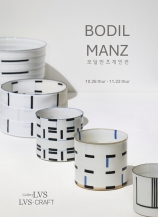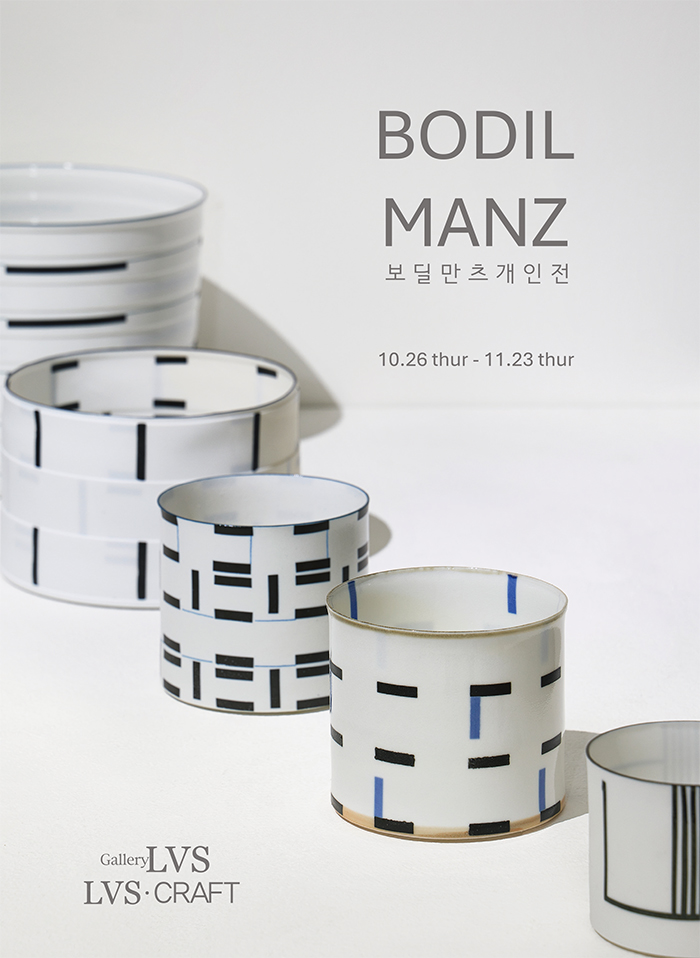신사동 갤러리 LVS에서 보딜 만츠의 두 번째 개인전을 개최한다.
한국에서는 2018년 이후, 5년 만에 여는 개인전이며 대표작인 전사지로 기하학 패턴을 표현한 백자 실린더를 30여점 선보인다. 보딜 만츠는 1943년 출생 덴마크의 도예가로, 유럽,미주,아시아 등 전 세계의 도예가들에게 영감을 주는 도자계의 대모이다. 1960년부터 63년 간 도자 연구와 작업을 해오고 있으며 달걀 껍질처럼 얇은 실린더를 현대적인 디자인으로 구사한 것이 대표 작품이다. 보딜 만츠는 유년 시절부터 물질과 디자인에 대한 호기심이 많았고, 창의성을 발휘해 손으로 만드는 것을 즐겼으며 언제나 다양한 아이디어를 구상하는 것을 좋아했다. 세계적으로 존경받는 도예가가 되었으며 80세의 나이에도 매일 새로운 작품에 대해 생각하고, 흥미로운 디자인을 만드는 것에 집중하고 있다. 보딜 만츠의 작품은 덴마크 디자인 뮤지엄과 뉴욕 현대 미술관, 런던 V&A, LA 카운티 미술관, 일본 기쿠 현대도예박물관, 프랑스 세브르 미술관 등 전 세계의 명성 있는 박물관에 소장되어 있다.
보딜 만츠는 도자 예술 역사상, 현대 도자에 가장 많은 영향을 준 작가로 평가받으며, ‘조형예술로서의 도자’ 개념을 확립하고 도자예술에 있어 자유로움의 가치를 일깨웠다. 보딜 만츠는 80년대 웅장한 규모의 다각형 캐스팅 작업과 90년대 장식적인 요소를 갖춘 투광성 있는 얇은 실린더 작업을 거쳐, 90년대 후반에 더욱 다양해지고 폭 넓어진 작업을 전개하였다. 특히 작품 안팎의 상호작용에 중점을 둔 실린더 형태의 작업과 표면 장식은 기하학이라는 범주로 한정할 수 없는 그 이상의 예술의 경지를 선사한다.
작가는 도자의 가장 기본 형태인 원통형에 실험정신을 가하여, 정형(定刑)적으로 여겨지던 틀을 넘어 자유로움을 실현해 보였다. 보딜 만츠 작업에서의 자유로움은 철저한 연구와 작가가 다루는 재료들의 물성에 대한 고찰 그리고 여러 실험적 태도로 완성된다. 원통형에서 시작된 작품은 입구에 층이 올라가고 옆면에 날개를 더해가는 등, 다각형 간의 조합을 통해 형태의 한계를 끊임없이 넘어 섰으며 기존 패러다임의 변화를 이끌었다.
보딜 만츠의 작업은 사용하자면 채울 수 있고, 오브제로서의 역할을 기대한다면 비울 수 있는 무한의 영역에 도달해 있다. 작품은 꽉 들어찬 연구의 집합체이면서 동시에 시각적으로 투명하고 얇다. 가득 담았으나 가볍고 장식적으로는 많은 상징과 문화, 역사를 녹여 냈음에도 불구하고 단순하고 깔끔하다.
얇고 가벼운 동시에 투광성을 지니는 작업은 뛰어난 감각에 의해 배치된 색색의 요소들과 더불어 빛을 발한다. 이때 작품의 안과 밖은 서로 기대어 상호작용을 하는데, 작업의 바깥쪽 요소와 내부의 요소는 서로 만나 그림자가 되기도 하고, 연결된 모양이 되기도 하며 훌륭한 협업자로서의 역할을 다한다. 외부의 가로선은 사이에 얇은 벽면을 두고 빛을 통해 내측의 세로선과 만나 완성된다. 이러한 선과 도형요소들은 간혹 가볍게 추상에 빗대어 지기도 하지만, 안팎이 노력하여 만들어낸 구성의 결정체라는 것을 깨닫는 순간, 빛을 사이에 두고 일어나는 기호의 결합은 물체 간에 흐르는 감정선으로 치환될 수 있으며 오브제가 주는 생명감을 경험하게 한다.
보딜 만츠 작품 속 이러한 ‘선(line)과 도형요소’는 한편으로 문화를 담고 있는 기호체계에 비유 할 수 있다. 이 체계들은 여러 국가의 문화와 역사적 산물, 자연환경으로부터 영감을 받아 작가의 실험적 접근에 의해 다양한 색을 지니고 녹아 들어 보딜 만츠만의 것으로 소화된다.
선 적인 요소에 대해서는 작품의 타이틀을 통해 크게 두 가지로 나눠서 볼 수 있다.
첫 번째로는 오브제가 어떤 작업에 대한 실험인지 밝히는 것이다. 이는 대각선, 울타리, 선과 사각형, 그늘진 면, 마름모, 가장자리, 검은 구조, 붉은 선 등의 표현들로 파악될 수 있다.
두 번째는 영감을 받은 대상, 장소나 지형에 대한 것이다. 그리스, 가을, 잔물결, 와디 (Wadi, 사막으로 평소에 물이 흐르지 않으나 큰비가 내리면 물이 흐르는 지형) 등이 그렇다. 작가는 도자기가 갖고 있는 유구한 역사와 이를 둘러싼 인류의 생활상, 그리고 덴마크를 비롯한 각국의 문화와 자연으로부터 많은 영감을 받았으며, 그 안에서 자연과 문화의 고유한 기호를 읽어내고 그들이 지닌 선과 면의 요소를 원통형의 형태에 접목시켜왔다.
작품은 투광성을 지닌 얇은 기물이 되기 위해 여러 과정을 거친다. 첫 과정으로는 종이를 접어 내외부의 공간을 구상하고 그 둘 사이에 일어날 상호작용을 계산하는 것이다. 작가는 “비친다는 것은 ‘내외부의 장식이 하나로 인식되는 것’이다” 라고 언급한 바 있다.
흙, 물, 전해액의 비율을 정확히 제어하여, 이 혼합물을 석고틀에 붓고 바로 따라내면 틀의 바닥과 옆면을 따라 얇은 막이 생겨난다. 작품이 틀에서 떨어지면, 꺼내어 900도에서 초벌을 하고 건조 후 흰색의 무광 유약을 발라 1300도 에서 소성한다. 마지막으로 색색의 박에 물을 묻혀 실린더 표면에 부착한 뒤, 색에 따라 달리 반응하는 온도에 맞춰 저온 소성 혹은 1300도의 고온소성을 하여 박의 색이 작품으로 옮겨지도록 한다.
ㅡㅡㅡㅡㅡㅡ
Bodil Manz’s second solo exhibition will hold at Gallery LVS in Sinsa-dong. This is the second solo exhibition in 5 years since the 2018 solo exhibition, and we will be showcasing about 30 white porcelain cylinders expressing geometric patterns using transfer paper, which is her representative work. Bodil Manz,born in 1943, is a Danish ceramic artist and the great master of ceramics who inspires ceramic artists around the world, including Europe, America, and Asia. She has been researching and working on ceramics for 63 years since 1960, and her representative work is a modern design using a cylinder as thin as an eggshell. Bodil Manz has been curious about materials and design since childhood, enjoyed being creative and making things with his hands, and always liked coming up with various ideas. She became a world-respected ceramic artist, and even at the age of 80, she thinks about new works every day and focuses on creating interesting designs. Bodil Manz's works are collected in renowned museums around the world, including the Danish Design Museum, the Museum of Modern Art in New York, the V&A in London, the Los Angeles County Museum of Art, the Museum of Modern Ceramic Art, Gifu, and the Sèvres Museum in France.
Bodil Manz is accepted as one of the most influential figures in contemporary ceramics in the history of ceramic art. She has developed influential powers beyond Europe, cultivating disciples all over the world. It can also be found from students and artists in Korea.
Bodil has worked on series of magnificent, large, cast polygons in the 1980s and worked on decorative, thin translucent cylinders in the 1990s which able to carry out a more diverse, multiplicity of work types in the late 1990s. In particular, focusing on the interplay between the exterior and interior decoration of the cylinder and the decoration cannot be limited by a word geometric but provides a level of art beyond.
Cylindrical form is accepted as the most basic form. The artist applies her experimental ideas to break out from the very basic ceramic form of a cylinder and expresses freely beyond the set frame. Freedom in Manz’s artwork is the result of a deep study of the property of the material and countless experiment she goes through. Cylindrical from is expended through steps added on the opening, wings to the side and through a combination of multiple polygonal casts. Limitation of forms has continuously overcome and led the change in paradigm.
The works can be filled and can be emptied depending it on purpose of functionality or as an object.
It is a tight accumulation of study and yet visually translucent and light. It is packed yet light. Decorations contain infinite culture symbol, culture and history yet simple and elegant.
The light, translucent work truly shines with the decoration in and out of the cylinder through the exceptional talent of the artist. Decoration in and out of the biscuit interplays with each other. They become a shadow of each other, become a joint form, together they support each other in the best way. With the help of light, Horizontal lines outside interacts with vertical lines over the thin layer. Often this lines and geometrical forms are easily referred to abstraction. However, when realizing the composition is the result of interaction between decoration in and out, it is possible to experience a new phase. Union of the decoration by the light displays to an emotional exchange between objects and can experience the vitality the object expresses.
There are ‘lines’ throughout the surface of the work that can be referred to a symbolic system of culture. These systems are inspired from different cultural, historical elements and natural environment. It meets with experimental ideas of the artist and re-interpreted into the artist’s unique artistic language, shining silently within the artwork.
Artwork title explains the element of line in two.
First, it identifies tests the object has gone through. Such as diagonal, fence, line and square, shady side, broadness, construction with black, red line and more.
Secondly, it tells about the subject, location, and terrain of inspiration, such as Greece, autumn, ripple water, and wadi. The rich history of ceramic culture, human life developed around the culture, culture, and nature of Denmark and other countries have influenced Manz. Elements of line and face from each culture are found from each natural and cultural identities and applied on cylindrical from.
To become the translucent biscuit, it needs to go through multiple processes. The first step is to plan space in and out by folding paper to calculate interaction between the two space. The artist has once mentioned, “transiency is ‘interpreting decorations in and out as one’”.
A proportioned mix of clay, water, and electrolyte is poured into the plaster mold and poured out right away, leaving a thin layer on the sides and bottom of the mold. When the cylinder is loosened from the mold, it is biscuit fired at 900 degrees and dried. After, white glaze is sprayed and fired at 1300 degrees. Lastly, colored foils are dabbed with water onto the cylinder and hi-fired 1300 degree or lower, depending on the property of colored foils. Then the colors are transferred to the body of the cylinder.


